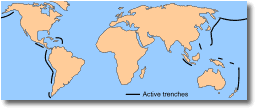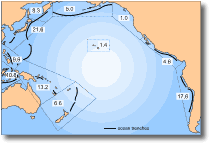
|
||||||||||||||||||||||||||||||||||||||||||||||||||||||||||||||||||||||||||||||||||||||||||||||||||||||||||||||||||||||||||||||||||||||||||||||||||||||||||||||||||||||
|
|
||||||||||||||||||||||||||||||||||||||||||||||||||||||||||||||||||||||||||||||||||||||||||||||||||||||||||||||||||||||||||||||||||||||||||||||||||||||||||||||||||||||
Tsunami HazardTsunamis represent a major hazard to many of the world's coastal cities because they are capable of causing significant damage and loss of life, both locally and at great distances from their point of origin. Since 1850, it is estimated that > 70 000 people have lost their lives in the Pacific due to tsunamis. Several million people live or work in tsunami hazard zones. Global occurrence of tsunamis
In the 100 years up to 1988 there were 517 tsunamis recorded in the Pacific (Table 1, Figs. 7 and 8). At least 19 of these were destructive, both locally and Pacific-wide.
Table
1. Tsunami activity around the Pacific ocean from 1888 to 1988
Numerous destructive tsunamis have emanated from near the oceanic trenches off Chile, Japan and Alaska in historic times (Table 2). Much information on Pacific tsunamis comes from accounts from these three regions and Hawaii. The regions of Kamchatka-Kuril Islands, Alaska-Aleutians and the west coast of South America are probably the regions of greatest potential for generating a tsunami with far-reaching remote-source consequences. The areas of Japan, Indonesia, Peru and Chile have the potential for devastating local tsunamis.
Chile Tsunamis originating off the Chilean coast have caused serious damage to the Pacific coast of Japan and Hawaii. The Pacific coasts of Canada and the U.S. are less affected, because of the direction of tsunami wave travel. Tsunamis generated in Chile have also been reported in New Zealand. Within Chile, 19 tsunamis are recorded and around 26 000 lives have been lost, including probably the most devastating tsunami of all time in 1868. Waves reached higher than 21 metres, ships were cast 4.8 km inland, and 25 000 residents of the city of Arica in Peru lost their lives. The tsunami generated in 1960 was also very large, with Pacific-wide effects. Japan Over 21% of all known Pacific-sourced tsunamis have been generated in the Japan-Taiwan region. This area is considered to be the most tsunamically active region in the world. Historic records show that coastal Japan has been struck by more than 250 tsunamis since 684 A.D. Many of the more recent events have been locally generated, most by offshore earthquakes east of Hokkaido. Of the distal-sourced tsunamis affecting Japan, those originating off the South American coast present the greatest danger. Japan has suffered the greatest loss of life (>100 000 deaths) and greatest destruction of property of any country in the world from tsunamis. In just two events in 1896 and 1933, at least 30 000 people lost their lives. The greatest damage was caused by the 1896 Meiji Sanriji tsunami, following a magnitude 7.6 earthquake off the Sanriku coast. Waves exceeding 24 m in places caused 27 122 deaths and destroyed 10 716 homes. The death toll was very high because the tsunami struck during a celebration, when people were crowding the streets. Alaska and the Aleutians The southern coast of Alaska, including the Aleutians has sourced many large and destructive tsunamis which principally affect the Pacific coast of the U.S. and Canada, and Hawaii. Alaska is also frequently affected by locally generated tsunamis. Twenty-six tsunamis have been generated in this region, with 12 causing major destruction and three that were recorded throughout the Pacific basin. The largest runup of all time was recorded in a landslide generated wave in an Alaskan fjord. The wave reached 525 m, and two fishing boats disappeared. The most destructive event know from this region was in 1964, causing 107 deaths locally and US$ 84 million in property damage. Hawaiian Islands The Hawaiian Islands have experienced numerous tsunamis from distant origins due to their location in the central Pacific, their orientation to the oceanic trenches and the lack of a surrounding continental shelf. Tsunami sources include Alaska (1946, 1957, 1964), Chile (1960), Japan (1933), and Kamchatka (1923, 1952). Over the last 100 years 63 tsunamis have been observed at Hawaii, seven initiated locally. Sixteen of these events have caused US$110 million in damage and taken over 400 lives. The most damaging, distal-sourced tsunamis to strike Hawaii were in 1868, 1946, 1960 and 1964 (Table 2). A locally generated tsunami in 1868 caused 81 fatalities and another in 1975 caused 2 fatalities and US$1.5 million in property damage. Indonesia Indonesia has experienced at least 50 destructive tsunamis over the last 100 years causing at least 50 000 fatalities. Most of the tsunamis experienced in this area are locally generated and volcanism is associated with around 20% of them. This leads to some unusual features associated with Indonesian tsunamis. In 1968 after a reported tsunami, no trace could be found of the island of Tuguan or any of its inhabitants. The most destructive tsunami occurred during the 1883 eruption of Krakatoa. Waves rose more than 30 m, resulting in 36 000 deaths in the Sunda Strait. The most recent event occurred in 1992, where around 1100 people were killed by an earthquake-generated tsunami off the coast of Flores. Philippines Thirteen destructive tsunamis are recorded from this region. Two large events in 1863 and 1976 accounted for 95% of the 45 600 people killed in this area by tsunamis. In 1976 a local earthquake generated a tsunami with waves up to 5 m high, causing 5000-8000 deaths. Papua New Guinea - Solomon Island area This is another area affected by volcanic tsunamis. Of 78 recorded tsunamis 12% were associated with volcanism, with the most disastrous generated during the 1888 eruption of a volcano on Ritter Island. More than 400 people have been killed in this area in recorded history. West Coast U.S.A. Relatively minor damage has been sustained in this area, with only 9 destructive tsunamis in the last 100 years. The worst was the 1964 Alaskan tsunami. In total 15 lives have been lost here, but US$10 million in property damages has been incurred. The main source of destructive tsunamis for the west coast of the U.S. is the Alaska-Aleutian Island area. Kamchatka and Kuril Islands Incomplete records have been kept in this area, but 10 destructive tsunamis have been observed causing a few deaths. An unusual feature of the locally observed tsunamis here is that they contain large blocks of ice within them, which become stranded on shore. This is a source region for remote-source tsunamis that are recorded in Japan and Hawaii. Tsunami effects Damage caused by tsunamis principally results from: impact of tsunami waves and runup on structures (e.g. houses, harbours)
Eyewitnesses describe that much of the initial damage results from direct impact of waves on structures such as breakwaters and harbour installations, and wave runup on coastal buildings. Buildings weakened by the initial impact of wave runup, and objects such as railway carriages, cranes, storage tanks, boats and trees are then carried out to sea by the strong drag forces of the backwash. Much additional damage results from the undermining of foundations by the backwash. Debris-laden waves then return to shore, inflicting additional damage; the force of the water and moving debris tends to raze all obstructions. Failure of weakened structures and ground subsidence following earthquake activity give rise to secondary hazards such as oil spills, sewerage leaks and urban fires. The principal loss of life is through drowning. However, the secondary effects can in some cases be enormous. Following the 1964 Alaska earthquake, oil storage tanks in Seward were ruptured, the oil spilt onto the sea and ignited leading to 10 m-high fiery waves inundating the waterfront area. In Nicaragua, following a tsunami in 1992, sewerage contaminated wells, causing an outbreak of cholera. Similar disease potential exists where large numbers of people are left homeless and living in refugee camps (e.g. after the 1992 Flores Island tsunami, 90 000 people were left homeless).
|
||||||||||||||||||||||||||||||||||||||||||||||||||||||||||||||||||||||||||||||||||||||||||||||||||||||||||||||||||||||||||||||||||||||||||||||||||||||||||||||||||||||
|
||||||||||||||||||||||||||||||||||||||||||||||||||||||||||||||||||||||||||||||||||||||||||||||||||||||||||||||||||||||||||||||||||||||||||||||||||||||||||||||||||||||



